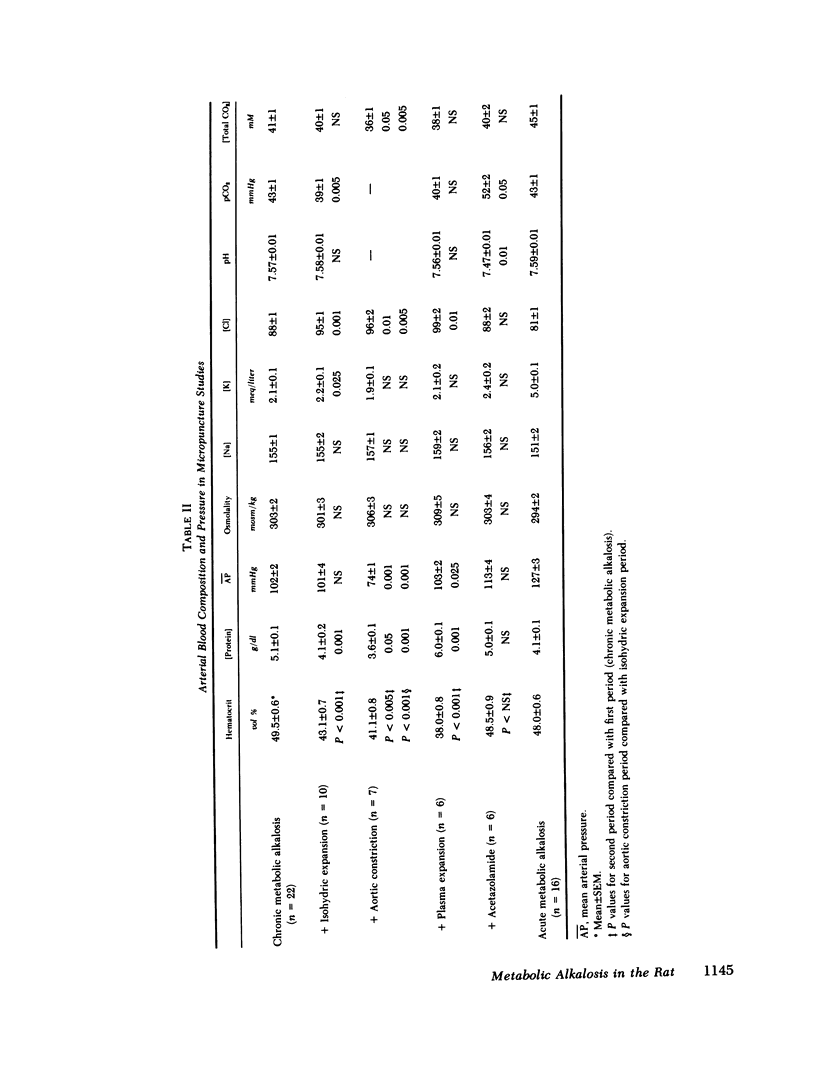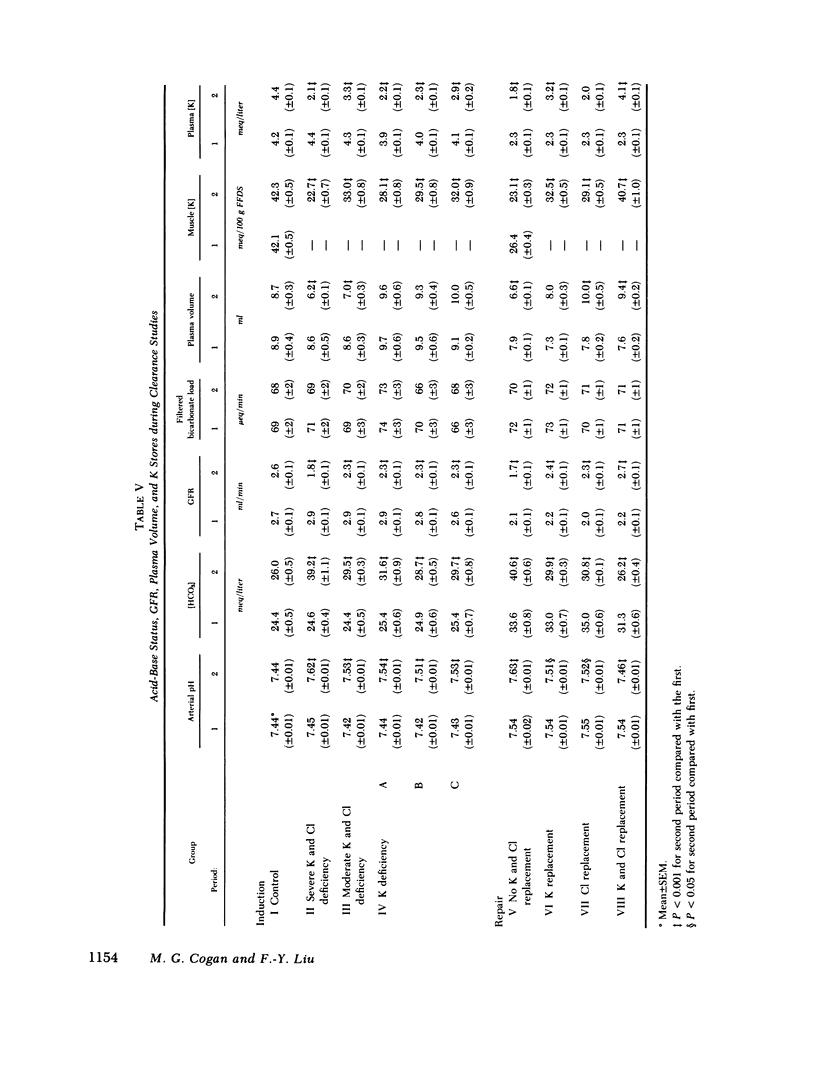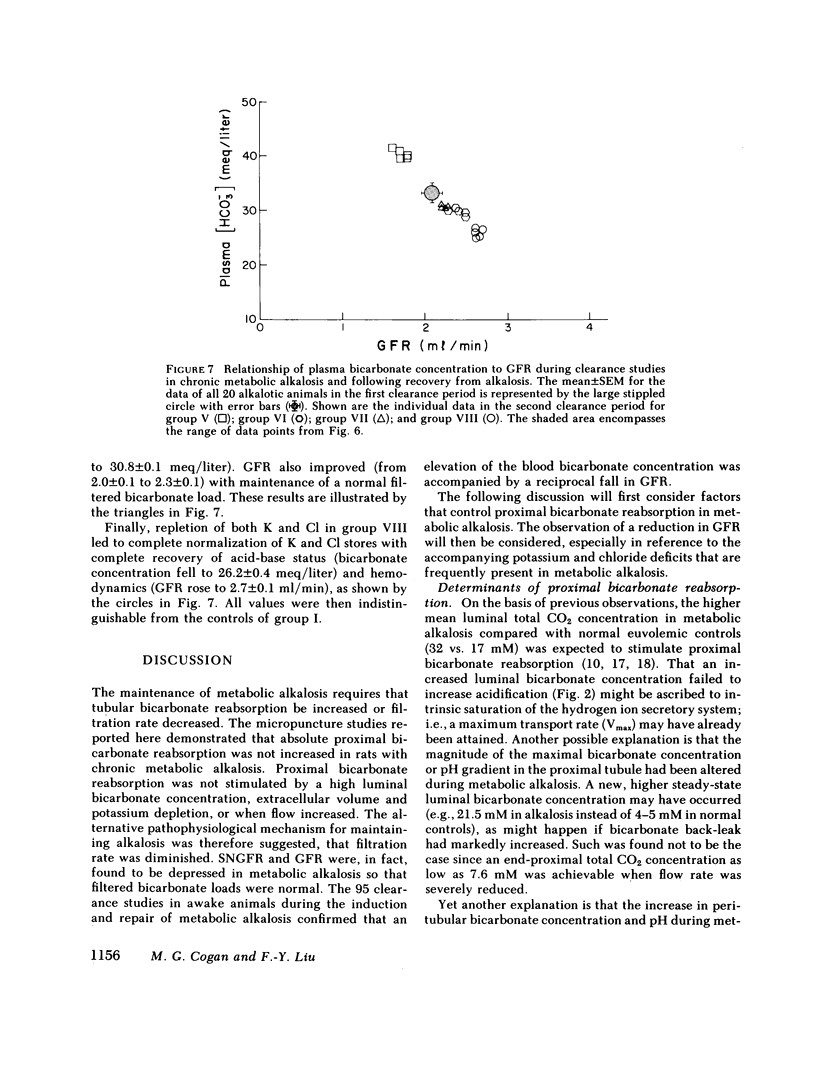Abstract
Maintenance of chronic metabolic alkalosis might occur by a reduction in glomerular filtration rate (GFR) without increased bicarbonate reabsorption or, alternatively, by augmentation of bicarbonate reabsorption with a normal GFR. To differentiate these possibilities, free-flow micropuncture was performed in alkalotic Munich-Wistar rats with a glomerular ultrafiltrate total CO2 concentration of 46.5 +/- 0.9 mM (vs. 27.7 +/- 0.9 mM in controls). Alkalotic animals had a markedly reduced single nephron GFR compared with controls (27.4 +/- 1.5 vs. 51.6 +/- 1.6 nl/min) and consequently unchanged filtered load of bicarbonate. Absolute proximal bicarbonate reabsorption in alkalotic animals was similar to controls (981 +/- 49 vs. 1,081 +/- 57 pmol/min), despite a higher luminal bicarbonate concentration, contracted extracellular volume, and potassium depletion. When single nephron GFR during alkalosis was increased toward normal by isohydric volume expansion or in another group by isotonic bicarbonate loading, absolute proximal bicarbonate reabsorption was not substantially augmented and bicarbonaturia developed. To confirm that a fall in GFR occurs during metabolic alkalosis, additional clearance studies were performed. Awake rats were studied before and after induction of metabolic alkalosis associated with varying amounts of potassium and chloride depletion. In all cases, the rise in blood bicarbonate concentration was inversely proportional to a reduction in GFR; filtered bicarbonate load remained normal. In conclusion, a reduction in GFR is proposed as being critical for maintaining chronic metabolic alkalosis in the rat. Constancy of the filtered bicarbonate load allows normal rates of renal bicarbonate reabsorption to maintain the alkalotic state.
Full text
PDF



















Images in this article
Selected References
These references are in PubMed. This may not be the complete list of references from this article.
- ARIEL I. M., MILLER F. The effects of hypochloremia upon renal function in surgical patients. Surgery. 1950 Sep;28(3):552–567. [PubMed] [Google Scholar]
- Abbrecht P. H. Effects of potassium deficiency on renal function in the dog. J Clin Invest. 1969 Mar;48(3):432–442. doi: 10.1172/JCI106000. [DOI] [PMC free article] [PubMed] [Google Scholar]
- Alpern R. J., Cogan M. G., Rector F. C., Jr Effect of luminal bicarbonate concentration on proximal acidification in the rat. Am J Physiol. 1982 Jul;243(1):F53–F59. doi: 10.1152/ajprenal.1982.243.1.F53. [DOI] [PubMed] [Google Scholar]
- Alpern R. J., Cogan M. G., Rector F. C., Jr Effects of extracellular fluid volume and plasma bicarbonate concentration on proximal acidification in the rat. J Clin Invest. 1983 Mar;71(3):736–746. doi: 10.1172/JCI110821. [DOI] [PMC free article] [PubMed] [Google Scholar]
- Bank N., Aynedjian H. S. A micropuncture study of renal bicarbonate and chloride reabsorption in hypokalaemic alkalosis. Clin Sci. 1965 Aug;29(1):159–170. [PubMed] [Google Scholar]
- Beck N., Shaw J. O. Thromboxane B2 and prostaglandin E2 in the K+-depleted rat kidney. Am J Physiol. 1981 Feb;240(2):F151–F157. doi: 10.1152/ajprenal.1981.240.2.F151. [DOI] [PubMed] [Google Scholar]
- Berry C. A., Cogan M. G. Influence of peritubular protein on solute absorption in the rabbit proximal tubule. A specific effect on NaCl transport. J Clin Invest. 1981 Aug;68(2):506–516. doi: 10.1172/JCI110282. [DOI] [PMC free article] [PubMed] [Google Scholar]
- Brunner F. P., Rector F. C., Jr, Seldin D. W. The mechanism of the urinary concentrating defect in potassium deficient rats. Pflugers Arch Gesamte Physiol Menschen Tiere. 1966;290(3):202–210. doi: 10.1007/BF00363123. [DOI] [PubMed] [Google Scholar]
- Chan Y. L., Biagi B., Giebisch G. Control mechanisms of bicarbonate transport across the rat proximal convoluted tubule. Am J Physiol. 1982 May;242(5):F532–F543. doi: 10.1152/ajprenal.1982.242.5.F532. [DOI] [PubMed] [Google Scholar]
- Cogan M. G., Maddox D. A., Lucci M. S., Rector F. C., Jr Control of proximal bicarbonate reabsorption in normal and acidotic rats. J Clin Invest. 1979 Nov;64(5):1168–1180. doi: 10.1172/JCI109570. [DOI] [PMC free article] [PubMed] [Google Scholar]
- Cogan M. G., Rector F. C., Jr Determinants of proximal bicarbonate, chloride, and water reabsorption during carbonic anhydrase inhibition. Am J Physiol. 1982 Mar;242(3):F274–F284. doi: 10.1152/ajprenal.1982.242.3.F274. [DOI] [PubMed] [Google Scholar]
- Cogan M. G., Rector F. C., Jr Proximal reabsorption during metabolic acidosis in the rat. Am J Physiol. 1982 May;242(5):F499–F507. doi: 10.1152/ajprenal.1982.242.5.F499. [DOI] [PubMed] [Google Scholar]
- Cohen J. J. Correction of metabolic alkalosis by the kidney after isomertric expansion of extracellular fluid. J Clin Invest. 1968 May;47(5):1181–1192. doi: 10.1172/JCI105807. [DOI] [PMC free article] [PubMed] [Google Scholar]
- Cohen J. J. Selective Cl retention in repair of metabolic alkalosis without increasing filtered load. Am J Physiol. 1970 Jan;218(1):165–170. doi: 10.1152/ajplegacy.1970.218.1.165. [DOI] [PubMed] [Google Scholar]
- Cohen L. H., Steinmetz P. R. Control of active proton transport in turtle urinary bladder by cell pH. J Gen Physiol. 1980 Sep;76(3):381–393. doi: 10.1085/jgp.76.3.381. [DOI] [PMC free article] [PubMed] [Google Scholar]
- De Mello Aires M., Malnic G. Micropuncture study of acidification during hypochloremic alkalosis in the rat. Pflugers Arch. 1972;331(1):13–24. doi: 10.1007/BF00587187. [DOI] [PubMed] [Google Scholar]
- GIEBISCH G., MACLEOD M. B., PITTS R. F. Effect of adrenal steroids on renal tubular reabsorption of bicarbonate. Am J Physiol. 1955 Dec;183(3):377–386. doi: 10.1152/ajplegacy.1955.183.3.377. [DOI] [PubMed] [Google Scholar]
- HOLLIDAY M. A., EGAN T. J. Changes in GFR and C-H2O before and after repair of K deficiency in rats. Am J Physiol. 1962 Apr;202:773–776. doi: 10.1152/ajplegacy.1962.202.4.773. [DOI] [PubMed] [Google Scholar]
- Jones J. W., Sebastian A., Hulter H. N., Schambelan M., Sutton J. M., Biglieri E. G. Systemic and renal acid-base effects of chronic dietary potassium depletion in humans. Kidney Int. 1982 Feb;21(2):402–410. doi: 10.1038/ki.1982.36. [DOI] [PubMed] [Google Scholar]
- Kassirer J. P., London A. M., Goldman D. M., Schwartz W. B. On the pathogenesis of metabolic alkalosis in hyperaldosteronism. Am J Med. 1970 Sep;49(3):306–315. doi: 10.1016/s0002-9343(70)80021-3. [DOI] [PubMed] [Google Scholar]
- Kassirer J. P., Schwartz W. B. Correction of metabolic alkalosis in man without repair of potassium deficiency. A re-evaluation of the role of potassium. Am J Med. 1966 Jan;40(1):19–26. doi: 10.1016/0002-9343(66)90183-5. [DOI] [PubMed] [Google Scholar]
- Kassirer J. P., Schwartz W. B. The response of normal man to selective depletion of hydrochloric acid. Factors in the genesis of persistent gastric alkalosis. Am J Med. 1966 Jan;40(1):10–18. doi: 10.1016/0002-9343(66)90182-3. [DOI] [PubMed] [Google Scholar]
- Kunau R. T., Jr, Frick A., Rector F. C., Jr, Seldin D. W. Micropuncture study of the proximal tubular factors responsible for the maintenance of alkalosis during potassium deficiency in the rat. Clin Sci. 1968 Apr;34(2):223–231. [PubMed] [Google Scholar]
- Kurtzman N. A., White M. G., Rogers P. W. The effect of potassium and extracellular volume on renal bicarbonate reabsorption. Metabolism. 1973 Mar;22(3):481–492. doi: 10.1016/0026-0495(73)90040-1. [DOI] [PubMed] [Google Scholar]
- Levine D. Z., Walker T., Nash L. A. Effects of KCl infusions on proximal tubular function in normal and potassium-depleted rats. Kidney Int. 1973 Nov;4(5):318–325. doi: 10.1038/ki.1973.123. [DOI] [PubMed] [Google Scholar]
- Linas S. L., Dickmann D. Mechanism of the decreased renal blood flow in the potassium-depleted conscious rat. Kidney Int. 1982 May;21(5):757–764. doi: 10.1038/ki.1982.94. [DOI] [PubMed] [Google Scholar]
- Linas S. L. Mechanism of hyperreninemia in the potassium-depleted rat. J Clin Invest. 1981 Aug;68(2):347–355. doi: 10.1172/JCI110262. [DOI] [PMC free article] [PubMed] [Google Scholar]
- Luke R. G., Levitin H. Impaired renal conservation of chloride and the acid-base changes associated with potassium depletion in the rat. Clin Sci. 1967 Jun;32(3):511–526. [PubMed] [Google Scholar]
- Maddox D. A., Price D. C., Rector F. C., Jr Effects of surgery on plasma volume and salt and water excretion in rats. Am J Physiol. 1977 Dec;233(6):F600–F606. doi: 10.1152/ajprenal.1977.233.6.F600. [DOI] [PubMed] [Google Scholar]
- NEEDLE M. A., KALOYANIDES G. J., SCHWARTZ W. B. THE EFFECTS OF SELECTIVE DEPLETION OF HYDROCHLORIC ACID ON ACID-BASE AND ELECTROLYTE EQUILIBRIUM. J Clin Invest. 1964 Sep;43:1836–1846. doi: 10.1172/JCI105057. [DOI] [PMC free article] [PubMed] [Google Scholar]
- ROBERTS K. E., RANDALL H. T., SANDERS H. L., HOOD M. Effects of potassium on renal tubular reabsorption of bicarbonate. J Clin Invest. 1955 May;34(5):666–672. doi: 10.1172/JCI103116. [DOI] [PMC free article] [PubMed] [Google Scholar]
- SCHWARTZ W. B., RELMAN A. S. Metabolic and renal studies in chronic potassium depletion resulting from overuse of laxatives. J Clin Invest. 1953 Mar;32(3):258–271. doi: 10.1172/JCI102735. [DOI] [PMC free article] [PubMed] [Google Scholar]
- SELDIN D. W., WELT L. G., CORT J. H. The role of sodium salts and adrenal steroids in the production of hypokalemic alkalosis. Yale J Biol Med. 1956 Dec;29(3):229–247. [PMC free article] [PubMed] [Google Scholar]
- STRUYVENBERG A., DE GRAEFF J., LAMEIJER L. D. THE ROLE OF CHLORIDE IN HYPOKALEMIC ALKALOSIS IN THE RAT. J Clin Invest. 1965 Feb;44:326–338. doi: 10.1172/JCI105146. [DOI] [PMC free article] [PubMed] [Google Scholar]
- Sasaki S., Berry C. A., Rector F. C., Jr Effect of luminal and peritubular HCO3(-) concentrations and PCO2 on HCO3(-) reabsorption in rabbit proximal convoluted tubules perfused in vitro. J Clin Invest. 1982 Sep;70(3):639–649. doi: 10.1172/JCI110658. [DOI] [PMC free article] [PubMed] [Google Scholar]
- Seldin D. W., Rector F. C., Jr Symposium on acid-base homeostasis. The generation and maintenance of metabolic alkalosis. Kidney Int. 1972 May;1(5):306–321. doi: 10.1038/ki.1972.43. [DOI] [PubMed] [Google Scholar]
- Ullrich K. J., Radtke H. W., Rumrich G. The role of bicarbonate and other buffers on isotonic fluid absorption in the proximal convolution of the rat kidney. Pflugers Arch. 1971;330(2):149–161. doi: 10.1007/BF00643031. [DOI] [PubMed] [Google Scholar]
- Ullrich K. J., Rumrich G., Baumann K. Renal proximal tubular buffer-(glycodiazine) transport. Inhomogeneity of local transport rate, dependence on sodium, effect of inhibitors and chronic adaptation. Pflugers Arch. 1975 Jun 26;357(3-4):149–163. doi: 10.1007/BF00585971. [DOI] [PubMed] [Google Scholar]
- Vurek G. G., Warnock D. G., Corsey R. Measurement of picomole amounts of carbon dioxide by calorimetry. Anal Chem. 1975 Apr;47(4):765–767. doi: 10.1021/ac60354a024. [DOI] [PubMed] [Google Scholar]





